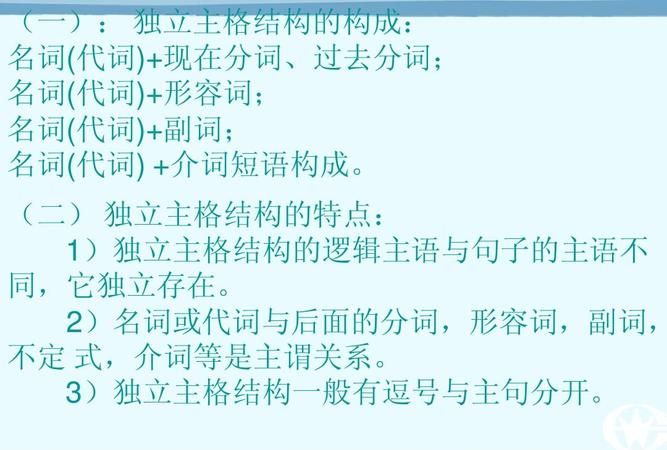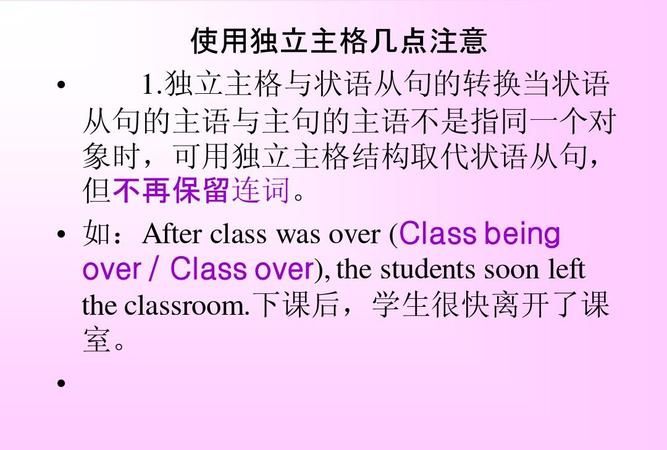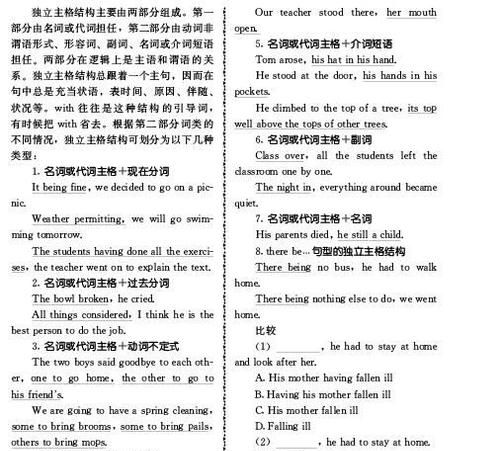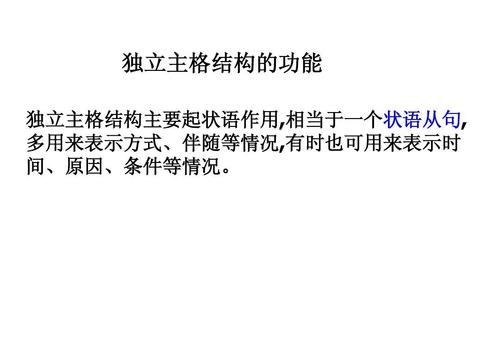一提及独立主格结构用法详解 是大家最关心的。有必要科普一下,独立主格结构详解和独立主格结构的用法及类型独立主格结构用法详解 的内容,令您更加清楚了解英语独立主格结构的详解,接下来一起看看。
独立主格结构用法详解 :独立主格结构 讲解具体包括用法
一、独立主格结构的概念及基本构成形式
独立主格结构(the absolute structure)是由名词或代词加上分词或分词短语构成的一种独立结构,用于修饰整个句子,而不是一个词或词组。独立主格结构中的名词或代词与其后的分词或分词短语构成逻辑上的主谓关系。这种结构与主句不发生句法上的联系,独立主格结构的位置相当灵活,可置于主句前、主句末或主句中,常由逗号将其与主句分开。需特别注意的是,独立主格结构与主句之间不能使用任何连接词。例如:
1)Night enshrouding the earth,nobody could make out what the dark mass was from a distance.(黑夜笼罩大地,谁也看不清远处黑压压的一片是什么东西。)
独立主格结构多用于书面语,尤其是描述性语言中,在口语和非正式文体中,一般用从句或两个句子来代替。例如,上述例句可变为:
二、独立主格结构的特殊构成形式
独立主格结构除上述基本构成形式,即名词/代词+分词(短语)外,还有如下特殊构成形式。
1.名词+介词短语
1)The mayor of Hiroshima strode at a leisure pace toward the puzzled journalist,a bunch of flowers in his hands.(广岛市市长双手捧着一束鲜花,迈着方步走向那个迷惑不解的记者。)
2.名词+形容词(短语)
1)The Trojans asleep,the Greek soldiers crept out of the hollow wooden horse.(特洛伊人睡着了,于是希腊士兵从中空的木马里悄悄爬了出来。)
3.名词+副词
1)This little excitement over,nothing was to be done but to return to a steadfast gaze at my mute companion.(一阵小小的兴奋过后,除了再去死死地盯着我的哑伴外,别无它事可干了。)
此外,with常常用在独立主格结构前,构成介词短语作状语。这种用法中的with不表达什么意义,因而常可省略。请看例句:
1)With a revolver in his right hand, Johnny hurled his muscular body against the door and smashed it down with a crash.(约翰尼右手拿着左轮手枪,健壮的身体猛扑在门上,轰隆一声把门撞开了。)
三、独立主格结构的用法
独立主格结构在句中一般作状语,表示时间、条件、原因、伴随状况等。
1.作时间状语
1)My shoes removed,I entered a low-ceilinged room,treading cautiously on the soft tatami matting.=After my shoes were removed, I entered a low-ceilinged room,treading cautiously on the soft tatami matting.(我脱掉鞋子后,走进一间屋顶很低的房间,小心翼翼地踩在柔软的塌塌米垫子上。)
2.作条件状语
1)Weather permitting,they will go on an outing to the beach tomorrow.=If weather permits,they will go on an outing to the beach tomorrow.(如果天气允许的话,他们将在明天组织一次海滨小游。)

独立主格结构用法详解 :独立主格结构的用法及类型
独立主格结构由两部分组成,前一部分是名词或者代词,后一部分是非谓语动词(不定式、动名词和分词)或形容词、副词、名词或介词短语。前后两部分具有逻辑主谓关系。
独立主格结构在句中做状语,多用于书面语。 独立主格结构本身不是句子,在句子中作状语,表示时间、原因、条件、伴随、目的等。
用法:
用作时间状语
The work done(=After the work had been done), we went home. 工作完成后,我们就回家了。
用作条件状语
Weather permitting(=If weather permits), they will go on an outing to the beach tomorrow. 如果天气允许的话,他们将在明天组织一次海滨小游。
用作原因状语
An important lecture to be given tomorrow(=As an important lecture will be given tomorrow), the professor has to stay up late into the night. 因为明天要发表一个重要的演讲,教授不得不熬夜到很晚。
用作伴随状语
He was lying on the grass,his hands crossed under his head(=and his hands were crossed under his head).他躺在草地上,将两手交叉枕在脑后。
表示补充说明
We redoubled our efforts,each man working like two. 我们加倍努力,一个人干两个人的活。
*注:独立主格结构表示时间、条件或原因时,相当于一个状语从句,一般放在句首,表示原因时还可放在句末;表伴随状况或补充说明时,相当于一个并列句,通常放于句末。
类型:
1、一般独立主格形式
与主句逻辑关系松散
形式为: n. + -ed/-ing形式; n. +不定式; n. +介词短语; n. +形容词; n. +副词;
名词/主格代词+现在分词
2、名词/主格代词与现在分词之间是主动关系。
如:
The girl staring at him(= As the girl stared at him), he didn't know what to say. 姑娘两眼望着他,他不知道说什么好。
Time permitting(= If time permits), we will go for an outing tomorrow. 如果时间允许的话,我们明天去郊游。
3、名词/主格代词+过去分词
名词/主格代词与过去分词之间是被动关系。
如:
The problems solved(= As the problems were solved), the quality has been improved. 随着问题的解决,质量已经提高了。
Her glasses broken(= Because her glasses were broken), she couldn't see the words on the blackboard. 由于眼镜摔坏了,她看不见黑板上的字。
4、名词/主格代词+不定式
名词/主格代词与不定式之间是主动关系,且强调的是一次具体性的动作。
如:
He is going to make a model plane,some old parts to help. 借助于一些旧零件,他要做一个飞机模型。
They said good-bye to each other,one to go home, the other to go to the bookstore. 他们道别后,一个回了家,一个去了书店。
5、名词/主格代词+形容词
如:
An air accident happened to the plane,nobody alive. 那架飞机遭遇了空难,无一人生还。
So many people absent, the meeting had to be called off. 这么多人缺席,会议不得不取消。
6、名词/主格代词+副词
如:
He put on his sweater ,wrong side out. 他把毛衣穿反了。
The meeting over, they all went home. 会议一结束,他们就都回家了。
7、名词/主格代词+介词短语
如:
The boy goes to the classroom,book in hand. 那男孩手里拿着书去教室。
Mary was sitting near the fire,her back towards the door.玛丽靠近火炉坐着,背对着门。
8、名词/主格代词+名词
His first shot failure,he fired again.
他第一枪没击中,又打了一枪。
Two hundred people died in the accident, many of them children.
两百人死于事故,其中有许多儿童。
9、- with 引导的独立主格:与主句逻辑关系紧密
形式为: with + n. + -ed/-ing形式; with + n. +adj.; with +n. +介词短语
with ( without)+宾语(名词/代词)+宾语补足语,宾语通常由名词或代词充当,但代词一定要用宾格。上文的独立主格结构的几种情况都适用于此结构。
如:
The girl hid her box without anyone knowing where it was.
小女孩把盒子藏了起来,没有人知道它在哪里。(without +名词/代词+动词的-ing形式)
Without a word more spoken, she left the meeting room.
她没再说什么话就离开了会议室。(without+名词/代词+动词的-ed形式)
The kid feels excited with so many places of interest to visit.
有这么多的名胜可参观,小孩很激动。(with+名词/代词+动词不定式)
The boy was walking, with his father ahead.
父亲在前,小孩在后走着。(with+名词/代词+副词)
He stood at the door, with a computer in his hand. 或He stood at the door, computer in hand.
他站在门口,手里拿着一部电脑。(with+名词/代词+介词短语)
With his son so disappointing, the old man felt unhappy.
由于儿子如此令人失望,老人感到很不快乐。(with+名词/代词+形容词)
在with (without) 的复合结构中,多数情况下with 能省略,但without 不能省略。
10、- each引导的强调型独立主格:
形式为:句子 +复数名词结尾 , each +介词短语/形容词短语/名词短语/-ing形式/-ed形式
这种独立主格结构为了强调句尾的复数名词
如:
Under the restructuring, the huge organization that operates the company's basic businesses will be divided into five groups,each with its own executive.(题源:《GMAT语法全解》白勇著,Page38)
11、-There being +名词(代词)
There being nothing else to do, we went home. 没有别的事可做,我们就回家了。
There being no further business, I declare the meeting closed. 没有再要讨论的事了,我宣布散会。
12、-It being +名词(代词)
It being Christmas, the government offices were closed. 由于圣诞节的缘故,政府机关都休息。
It being a holiday, all the shops were shut. 由于今天是假日,所有商店都关门了。

独立主格结构用法详解 :独立主格用法讲解
独立主格
1独立主格结构的构成:名词(代词)+现在分词、过去分词;
名词(代词)+形容词;
名词(代词)+副词;
名词(代词)+不定式;
名词(代词) +介词短语构成。
独立主格结构的特点:
1)独立主格结构的逻辑主语与句子的主语不同,它独立存在。
2)名词或代词与后面的分词,形容词,副词,不定式,介词等是主谓关系。
3)独立主格结构一般有逗号与主句分开。
例如: The test finished, we began our holiday. = When the test was finished, we began our holiday. 考试结束了,我们开始放假。
The president assassinated, the whole country was in deep sorrow. = After the president was assassinated, the whole country was in deep sorrow. 总统被谋杀了,举国上下沉浸在悲哀之中。
Weather permitting, we are going to visit you tomorrow. 天气允许,我们明天去看你。
This done, we went home. 工作完成后,我们才回家。
The meeting gone over, everyone tired to go home earlier. 会议结束后,每个人都想早点回家。
He came into the room, his ears red with cold. 他回到了房子里,耳朵冻得红通通的。
He came out of the library, a large book under his arm. 他夹着本厚书,走出了图书馆
2 with的复合结构作独立主格
表示伴随情况时,既可用分词的独立结构,也可用with的复合结构:with +名词(代词)+现在分词/过去分词/形容词/副词/不定式/介词短语。例如:
He stood there, his hand raised. = He stood there, with his hand raise.他举手着站在那儿。
典型例题
The murderer was brought in, with his hands ___ behind his back。
A. being tied B. having tied C. to be tied D. tied
答案D. with +名词(代词)+分词+介词短语结构。当分词表示伴随状况时,其主语常常用with来引导。由于本句中名词"手"与分词"绑"是被动关系,因此用过去分词,选D.
注意:
1) 独立主格结构使用介词的问题: 当介词是in时,其前后的两个名词均不加任何成分(如物主代词或冠词),也不用复数。但 with 的复合结构不受此限制。例如:A robber burst into the room, knife in hand.(hand前不能加his)劫匪冲进房间,手里拿着刀。
2) 当表示人体部位的词做逻辑主语时,及物动词用现在分词,不及物动词用过去分词。例如:
He lay there, his teeth set, his hand clenched, his eyes looking straight up.
他躺在那儿,牙紧咬,双手握拳,两眼直勾勾看着上面。
典型例题:
Weather___, we”ll go out for a walk.
A permitted B permitting C permits D for permitting
答案B. 本题中没有连词,它不是复合句,也不是并列句。 句中使用了逗号,且we 小写,可知其不是两个简单句。能够这样使用的只有独立主格或with的复合结构。据此判断,本句中使用的是独立结构,其结构为:名词+分词。 由于permit在这里翻译为”天气允许”,表主动,应用现在分词,故选B。
如果不会判断独立结构作状语的形式,不妨将句子改为条件句,例如本句改为If weather permits, we”ll go out for a walk. 然后将if 去掉,再将谓语动词改为非谓语动词即可

独立主格结构用法详解 :英语语法 独立主格结构的详解.
独立主格结构的构成:
名词(代词)+现在分词、过去分词;
名词(代词)+形容词;
名词(代词)+副词;
名词(代词)+不定式;

以上就是关于独立主格结构用法详解 ,英语独立主格结构的详解的全部内容,以及独立主格结构用法详解 的相关内容,希望能够帮到您。
